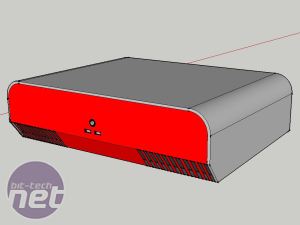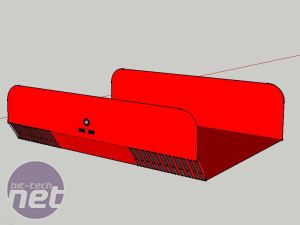
Design
Whether you prefer to design as you go along or plan to the millimetre beforehand, it's essential to make some sort of sketch or design before you start cutting. This not only reduces the risk of errors (hardware not fitting, panels not lining up etc) but you'll probably get ideas for improvements too. Planning in your head is all very well, but putting pen to paper (or pointer to SketchUp) will often give you a better perspective of your idea and may even allow you make it look even better.

Click to enlarge
Forum user wejjy's project called Interior Des(k)ign, which we can see above and to the right, is a classic example of paper sketches being transferred to SketchUp then into real form.
If you already know how to use a 3D rendering program, this will stand you in good stead for building your case. Being able to quickly and easily create a 3D model of your case will allow you to get exact measurements and also spot potential pitfalls.
Google's SketchUp is a great free 3D rendering program that's very popular with PC modders and more importantly for the beginner, there's already a huge library of pre-rendered hardware you can import and start placing in your 3D world, to get a real idea about how the hardware will fit in your unique case. Head over to http://scc.jezmckean.com to see all the hardware.
My initial Google SketchUp designs - Click to enlarge
Even if you just use pen and paper, this can make your life much easier when it comes to deciding about the specific shapes that will be involved and the materials you will use. More importantly, you're able to see how all the sections will eventually fit together and how. We started with numerous pencil sketches before deciding on a final design, which we then transferred to SketchUp. Here, even simple things like adding colour can impact on how you want the project to turn out.
Hardware
We've included hardware and design in this first update rather than separately because they go hand in hand, especially with smaller projects where space is a premium. You need to decide which is more important - the hardware or the final design of your case. Some designs may not allow for features such as large water-cooling systems, multiple graphics cards or stacks of hard disks. Likewise, if you're dead-set on using the latest Asus ATX ROG motherboard and a massively overclocked CPU, for example, you'll immediately be setting minimum dimensions for your case to cater for the motherboard and cooling.
This isn't to say you can't compromise - far from it. Half the fun of starting your project is striking a balance between the hardware and the case in terms of space, features and materials. For this project, we wanted to build a PC that was as small as possible, so a mini-ITX motherboard was the logical choice. We also discovered that SilverStone has on offer a fairly beefy SFX power supply (a smaller form factor PSU than the standard ATX size) so decided to use this to further decrease the required space.
The only issue with it is its rated power - at 450W it's not amazingly powerful when you consider we'd be using an overclocked Intel Core i5 2500K and a GeForce GTX 560 Ti. Thankfully, we had all the hardware we'd be using to hand and a stress test using Prime95 and Unigene Heaven to fully load the PC, resulting in a power draw of less than 320W. Even so, we ran the system like this doing everyday tasks and gaming for several weeks to make sure everything was okay.
We also wanted to include a capable water-cooling system, so we enlarged our original case designs slightly to be able to mount a 180mm radiator and 180mm SilverStone Air Penetrator fan in the roof, whilst also allowing for a pump and reservoir.

MSI MPG Velox 100R Chassis Review
October 14 2021 | 15:04











Want to comment? Please log in.